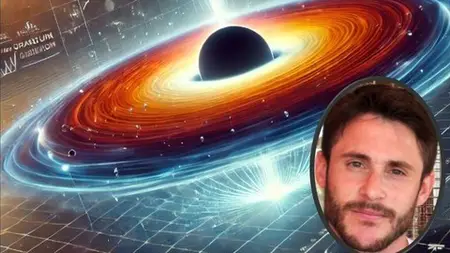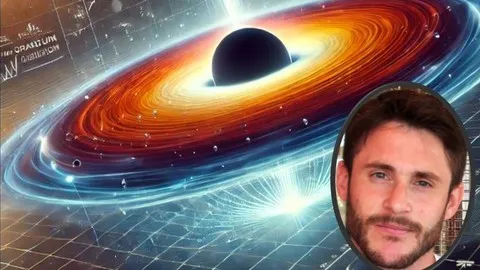Qft In Curved Spacetime: Hawking Radiation, Unruh Effect
Published 3/2025
MP4 | Video: h264, 1920x1080 | Audio: AAC, 44.1 KHz
Language: English | Size: 14.24 GB | Duration: 16h 56m
Published 3/2025
MP4 | Video: h264, 1920x1080 | Audio: AAC, 44.1 KHz
Language: English | Size: 14.24 GB | Duration: 16h 56m
Quantum Field Theory in curved spacetime, Hawking radiation, Unruh effect, quantum corrections to General Relativity
What you'll learn
Understand Quantum Fields in Curved Spacetime: Learn how quantum fields are formulated in non-Minkowskian geometries, explore vacuum states
Analyze Black Hole Thermodynamics and Radiation: Derive and interpret Hawking radiation, study black hole entropy, and examine evaporation processes
Master Mathematical Techniques for Quantum Corrections to Gravity: Develop proficiency in path integrals, heat kernel methods, zeta function regularization
Apply QFT in Curved Spacetime to Modern Research Topics: Investigate the Unruh effect, semiclassical gravity, quantum corrections to General Relativity
Explore the Role of Bogolyubov Transformations and Vacuum States: Understand how Bogolyubov coefficients relate different vacuum states, analyze Rindler vacuum
Develop a Strong Foundation in Lorentz and Poincaré Representations: apply these techniques to derive the DIrac equation in curved spacetime
Requirements
Background in Quantum Field Theory and General Relativity: Students should have a solid understanding of QFT and GR, including classical field theory, the Klein-Gordon equation, and the basics of curved spacetime.
Mathematical Proficiency: Familiarity with functional analysis, differential geometry, and advanced calculus is strongly recommended, as these mathematical tools are extensively used throughout the course.
Exposure to Path Integrals and Operator Formalism: While a full mastery is not required, prior exposure to the path integral formulation and operator-based quantization methods in quantum mechanics and QFT will be beneficial.
Description
This advanced course examines the interface of quantum field theory (QFT) and general relativity, focusing on the theoretical and mathematical structures that govern quantum fields in curved spacetime. The course is intended for graduate students, researchers, as well as professionals in theoretical physics.The syllabus includes the following key topics (not necessarily in this order):Foundations of QFT in Curved SpacetimeDefinition of quantum fields in non-Minkowskian geometries.Vacuum states, particle creation, and the semiclassical approach.Hawking RadiationDerivation and analysis of black hole radiation.Implications for black hole thermodynamics and entropy.Black hole lifetime and evaporation processesInsights from the holographic principle and Loop Quantum GravityThe Unruh EffectExamination of vacuum fluctuations as perceived by uniformly accelerated observers.Theoretical connection to the Rindler horizon and thermal effects.Rindler and Minkowski vacua, and the role of Bogolyubov coefficientsConnection between acceleration, temperature, and entropyMathematical Framework for the Calculation of Quantum Corrections to GravityPath integral formulation and its application to curved spacetimeHeat kernel methods, zeta function regularization, and renormalizationEuclidean quantum gravity and effective action approachesLorentz and Poincaré group representations in curved spacetimeApplications to Quantum Gravity & CosmologyQuantum corrections to General Relativity from effective field theoryScalar fields in expanding universes and inflationary modelsCasimir force, semiclassical gravity, and emergent spacetime modelsBy the end of the course, students will develop a thorough understanding of the core theoretical principles of QFT in curved spacetime, as well as their implications for fundamental physics. The course will equip participants with the tools necessary to engage in more advanced research in quantum gravity, black hole physics, and cosmology.Prerequisites:Participants should have a solid foundation in QFT and general relativity. Familiarity with advanced mathematical methods, including functional analysis and differential geometry, is strongly recommended. However, the first section recalls those relevant concepts of QFT, which are used extensively throughout the course.Course Format:The course is structured around "formal" lectures (aiming to stimulate physical and mathematical intuition), and critical discussions of seminal and contemporary research literature. It aims to provide a rigorous and comprehensive understanding of the subject.
Overview
Section 1: Introduction to the course
Lecture 1 General introductory video
Lecture 2 What is Quantum Field Theory in curved spacetime?
Lecture 3 Book resources (which are NOT mandatory to follow the course)
Lecture 4 More information about the content of the course
Section 2: Recap on Quantum Field Theory for scalar fields
Lecture 5 introduction to the section dedicated to the recap on QFT
Lecture 6 Reconciling quantum mechanics and Special Relativity
Lecture 7 Review of Classical Field Theory part 1
Lecture 8 Review of Classical Field Theory part 2
Lecture 9 Klein Gordon equation derived from Classical field theory
Lecture 10 Quantization of a Classical Field part 1
Lecture 11 Quantization of a Classical Field part 2
Lecture 12 Derivation of the spectrum of the Hamiltonian part 1
Lecture 13 Expression of the energy momentum tensor in Field Theory
Lecture 14 Annihilation and creation operators to determine the spectrum of the Hamiltonian
Lecture 15 Ground state and construction of states with a certain number of quanta
Lecture 16 Definition of the number operator
Lecture 17 Number operator acting on a two-particle state
Lecture 18 Invariant volume element in QFT
Section 3: Unruh effect and Hawking radiation
Lecture 19 lightcone coordinates
Lecture 20 scalar field in curved space, Rindler vacuum, Minkowski vacuum
Lecture 21 Bogolyubov transformations
Lecture 22 Coefficients in the Bogolyubov transformations
Lecture 23 Bogolyubov normalization condition
Lecture 24 Unruh effect
Lecture 25 Hawking radiation
Lecture 26 Thermodynamics of black holes
Lecture 27 The lifetime of blackholes
Lecture 28 Holographic principle and emergent gravity
Lecture 29 Black holes from the perspective of Loop Quantum Gravity
Lecture 30 The connection between General Relativity and thermodynamics
Lecture 31 Classical scalar field in an expanding universe
Lecture 32 Appendix on the Planck length
Section 4: Recap on Path Integrals
Lecture 33 Derivation of the path integral
Lecture 34 Mathematical and physical intuition behind the path integral
Lecture 35 Heuristic derivation of the path integral from classical field theory
Lecture 36 A different perspective: from the path integral to the Schrodinger equation
Lecture 37 Double Slit Experiment Analysis Using Path Integrals (implementation in MATLAB)
Lecture 38 Double-Slit Experiment using Path Integrals: some more physical considerations
Lecture 39 Appendix: Solving an Integral from Feynman's Book on Path Integrals
Section 5: Difficulties in the quantization of gravity
Lecture 40 Semiclassical gravity
Lecture 41 Why Quantum Gravity is hard
Lecture 42 Some possible approaches to Quantum Gravity: qualitative considerations
Section 6: Quantum effects of fields in vacuum: Casimir effect
Lecture 43 Quantum effects in vacuum: Casimir force in 1+1 dimensions
Lecture 44 Speculative considerations on Casimir effect and possible gravitational effects
Section 7: Quantum effects in gravity: path integrals in curved spacetime, Heat kernel
Lecture 45 Euclidean action for a scalar field coupled to gravity
Lecture 46 Effective action as a functional determinant
Lecture 47 Reformulation of the eigenvalue problem of a scalar field coupled to gravity
Lecture 48 Zeta function of a mathematical operator
Lecture 49 Heat kernel and quantum corrections to General Relativity
Lecture 50 Calculation of the Heat kernel in curved space part 1
Lecture 51 Calculation of the Heat kernel in curved space part 2
Lecture 52 Calculation of the Heat kernel in curved space part 3: matrix elements of K0
Lecture 53 Calculation of the Heat kernel in curved space part 4: matrix elements of K1
Lecture 54 Calculation of the Heat kernel in curved space part 5: corrections to GR
Lecture 55 Appendix: why can we make anything uself out of divergences in physics?
Section 8: Lorentz group, representations, spinors, Dirac equation in curved spacetime
Lecture 56 Lorentz and Poincare groups, representations, angular momentum, Lie algebras
Lecture 57 Derivation of the Lorentz Lie algebra
Lecture 58 Transformation of a vector field according to the Lorentz algebra
Lecture 59 Transformation of a spinor field derived by generalizing a vector field
Lecture 60 The generators of the transformation of a vector satisfy the Lorentz algebra
Lecture 61 The generators of the transformation of a spinor satisfy the Lorentz algebra
Lecture 62 Derivation of the commutator of angular momentum from the Lorentz Lie algebra
Lecture 63 Tetrads and Dirac equation in curved spacetime
Lecture 64 Appendix on the exponential of a matrix
Graduate Students & Researchers in Theoretical Physics: This course is designed for students pursuing master's or PhD-level studies in quantum field theory, general relativity, or related fields. It provides a deep exploration of QFT in curved spacetime, preparing learners for advanced research.,Physicists and Mathematicians Interested in Quantum Gravity: Researchers working in high-energy physics, cosmology, and mathematical physics will benefit from the rigorous treatment of topics such as black hole thermodynamics, semiclassical gravity, and quantum corrections to General Relativity.,Professionals Seeking Advanced Knowledge in Modern Theoretical Physics: Engineers, computational physicists, and professionals with a strong background in mathematical physics who want to understand quantum field theory beyond flat spacetime will find this course valuable.,Self-Learners with a Strong Theoretical Foundation: Passionate individuals with prior exposure to QFT and general relativity, even outside formal academia, will be able to follow the material, provided they have the necessary mathematical background.



